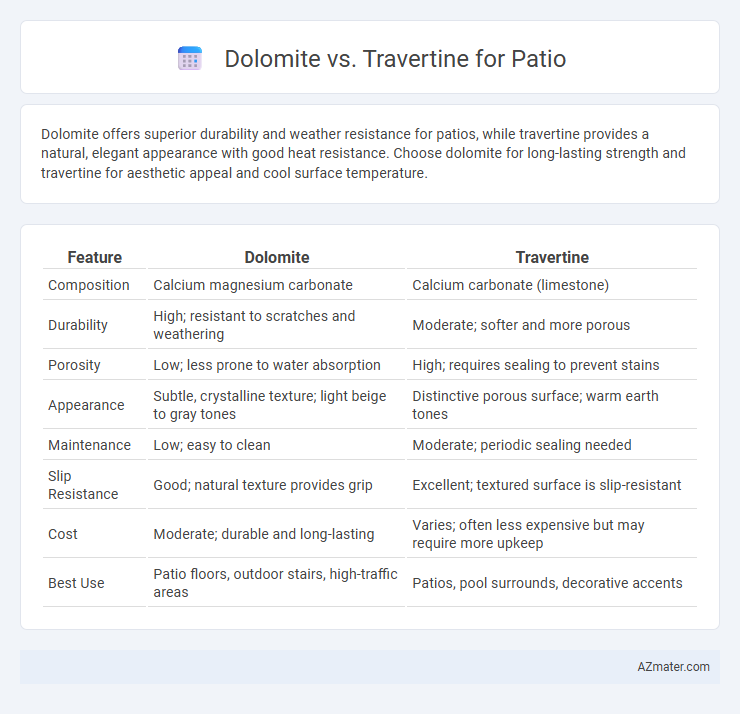Dolomite offers superior durability and weather resistance for patios, while travertine provides a natural, elegant appearance with good heat resistance. Choose dolomite for long-lasting strength and travertine for aesthetic appeal and cool surface temperature.
Table of Comparison
| Feature | Dolomite | Travertine |
|---|---|---|
| Composition | Calcium magnesium carbonate | Calcium carbonate (limestone) |
| Durability | High; resistant to scratches and weathering | Moderate; softer and more porous |
| Porosity | Low; less prone to water absorption | High; requires sealing to prevent stains |
| Appearance | Subtle, crystalline texture; light beige to gray tones | Distinctive porous surface; warm earth tones |
| Maintenance | Low; easy to clean | Moderate; periodic sealing needed |
| Slip Resistance | Good; natural texture provides grip | Excellent; textured surface is slip-resistant |
| Cost | Moderate; durable and long-lasting | Varies; often less expensive but may require more upkeep |
| Best Use | Patio floors, outdoor stairs, high-traffic areas | Patios, pool surrounds, decorative accents |
Introduction to Dolomite and Travertine
Dolomite and travertine are popular natural stone choices for patios, known for their durability and aesthetic appeal. Dolomite, a calcium magnesium carbonate mineral, offers a dense, hard surface with subtle gray and beige tones ideal for high-traffic outdoor areas. Travertine, formed from limestone deposits, features a porous texture with warm, earthy hues and natural pitted formations that provide excellent slip resistance in patio settings.
Key Differences Between Dolomite and Travertine
Dolomite is a dense, crystalline sedimentary rock known for its hardness and durability, making it highly resistant to weathering and ideal for high-traffic patio areas. Travertine is a porous form of limestone with a distinctive fibrous texture and natural pitted holes, offering a softer, more aesthetic surface but requiring regular sealing to prevent staining and damage. The key differences lie in Dolomite's superior hardness (rated 3.5-4 on the Mohs scale) versus Travertine's moderate softness (3-4 on the Mohs scale), porosity levels, and maintenance needs, which affect longevity and slip-resistance for outdoor patio applications.
Appearance and Color Variations
Dolomite offers a sleek, consistent appearance with colors ranging from white and gray to soft beige, providing a modern and elegant look for patios. Travertine showcases distinctive natural patterns with warm earth tones, including cream, tan, rust, and sandstone, creating a rustic and timeless aesthetic. The color variations in travertine are more pronounced, featuring natural pits and holes that add texture and character to outdoor spaces.
Durability and Longevity
Dolomite offers exceptional durability and resistance to weathering, making it an ideal choice for patios exposed to harsh climates. Travertine provides moderate durability with its porous structure, requiring regular sealing to maintain longevity. Over time, dolomite's hardness and density ensure a longer lifespan with minimal maintenance compared to travertine's susceptibility to erosion and staining.
Slip Resistance and Safety
Dolomite offers superior slip resistance compared to travertine due to its naturally rougher texture and higher durability, making it a safer choice for patios in wet conditions. Travertine, while aesthetically pleasing with its smooth surface and warm tones, can become slippery when polished or wet, increasing the risk of falls. Choosing dolomite enhances patio safety by reducing slip hazards, especially in outdoor environments prone to rain or poolside locations.
Maintenance Requirements
Dolomite patios require minimal maintenance due to their durability and resistance to weathering, needing only occasional cleaning to prevent dirt buildup. Travertine, while attractive, demands more care, including regular sealing to protect its porous surface from stains and moisture damage. Both materials benefit from prompt removal of debris to maintain appearance, but travertine's higher porosity makes it more susceptible to wear over time.
Weather Resistance and Outdoor Performance
Dolomite offers exceptional weather resistance due to its high density and low porosity, making it highly durable against rain, frost, and temperature fluctuations in outdoor patio settings. Travertine, while aesthetically appealing with its natural pores and softer texture, is more prone to weathering and requires sealing to maintain its outdoor performance and prevent water damage. Choosing Dolomite for patio use ensures long-lasting resilience and minimal maintenance in variable weather conditions.
Cost Comparison
Dolomite typically costs between $5 to $10 per square foot, making it a more affordable option for patio installations compared to travertine, which ranges from $15 to $30 per square foot. The lower price of dolomite stems from its abundant availability and simpler quarrying process, while travertine's higher cost is attributed to its unique porous texture and aesthetic appeal. Choosing between dolomite and travertine depends on budget flexibility and desired patio appearance, with dolomite offering cost efficiency and travertine providing premium elegance.
Installation Considerations
Dolomite offers a dense and durable surface that requires precise cutting tools and professional installation due to its hardness, making it ideal for long-lasting patios but potentially increasing labor costs. Travertine, being softer and more porous, allows for easier handling and faster installation but demands thorough sealing to prevent staining and damage from weather exposure. Both stones benefit from a stable, well-prepared base to avoid cracking and shifting, with proper grout selection enhancing longevity and aesthetic appeal.
Final Verdict: Choosing the Best Stone for Your Patio
Dolomite offers superior durability and resistance to weathering, making it ideal for high-traffic patios exposed to variable climates. Travertine provides a natural, porous surface with excellent heat resistance, perfect for warmer regions and a softer aesthetic appeal. For long-lasting strength and low maintenance, dolomite is the best choice, while travertine suits those prioritizing style and comfort in milder outdoor environments.

Infographic: Dolomite vs Travertine for Patio
 azmater.com
azmater.com